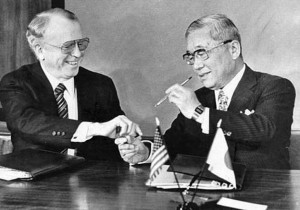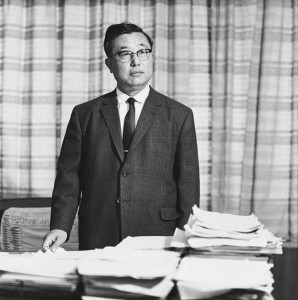
Former Toyota Pres. Eiji Toyoda shakes hands with GM Chairman Roger Smith, left, as they give the go to a new joint venture that marked Toyota's first manufacturing operation in the U.S.
Though long retired, Eiji Toyoda continued to have an influence on Japan’s biggest automaker right up to his death at 100.
Indeed, it was during his time leading Toyota Motor Co. that the automaker transformed itself from an ambitious, Japanese wannabe into a true, global force that would eventually overcome powerful competitors like General Motors to become the world’s largest automotive manufacturer.
While running the company founded by his cousin – originally as a loom maker – Eiji Toyoda helped create the “Toyota Way,” a hyper-efficient manufacturing system that many of those competitors today have copied in a bid to catch up to the Japanese giant.
“We mourn the loss of automotive pioneer Eiji Toyoda, whose contributions and leadership helped make Toyota what it is today,” said the automaker in a notice on its media site.
Toyoda’s death came five days after he marked his 100th birthday. He was being treated at the Toyota Memorial Hospital, in Toyota City, a medical facility originally founded in 1938 to treat company workers.

In an earlier era, Eiji Toyoda helped create the "kaizen," or continuous improvement, concept that became the heart of the "Toyota Way."
Eiji Toyoda was still a student at Tokyo Imperial University in the mid-1930s when his cousin, Sakichi, shifted from the textile business to automotive manufacturing. He would soon join the family business, overseeing the construction of a new plant and “honsha,” or headquarters, in Koromo, a town that would eventually be renamed Toyota City.
(Toyota hopes to redefine the hybrid with its Yaris R-Hybrid Concept. Click Here for a closer look.)
He didn’t simply settle into a management role, however. Toyoda spent his early years on the factory floor where he became well aware of the problems that led to quality issues and manufacturing snags. He would eventually reach out to an American guru – long snubbed by the U.S. auto industry – by the name of W. Edwards Demming – to offer advice and guidance.
With that understanding, Toyoda lent his support to a new, hyper-efficient production system that would soon allow the family company to churn out cars of high-quality at an unheard-of pace even while lowering production costs. It became known as “the Toyota Way,” as well as the Toyota Production System. The other key figure in its development was the late Taiichi Ohno, the hands-on manufacturing chief at Toyota for many years.
(Toyota a big winner as the U.S. auto market recovers. Click Here for more.)
Eiji Toyoda would become president of the carmaker in 1967 – in the Japanese system, becoming its all-powerful leader. It was a critical time following Toyota’s initially disastrous effort to gain a foothold in the American market, the world’s largest. Like its Japanese competitors, the company caught a break in the 1970s, when a pair of Mideast oil shocks roiled through the U.S. market, putting the spotlight on high-mileage Asian imports at the expense of Detroit’s Big Three.
By the end of the decade, Toyota and its Japanese competitors would become fixtures in the market, steadily gobbling up an ever-bigger share. But it would soon become Toyota’s reputation quality, over mileage, that entrenched the giant in the minds of Americans.
Though Toyoda retired as president in 1982, moving up to the traditionally ceremonial post of chairman, Eiji continued to serve as a venerated advisor. Among the other critical steps he is given credit for are the development of the Corolla, Toyota’s best-selling model worldwide – and its second-best-seller in the States – as well as the creation of the Lexus luxury division.
Perhaps one of the most significant symbols of Toyota’s growing power came shortly after the executive’s retirement as president. He can be seen in photographs taken during a ceremony in 1984 marking the opening of the NUMMI – or New United Motor Manufacturing Inc. – plant near San Francisco, shaking hands with General Motors’ then-Chairman Roger Smith.
GM agreed to the joint venture to gain insight into the Toyota production system, while Toyota wanted to see if that approach could be transferred to the U.S. Today, the Detroit maker’s own approach to manufacturing borrows heavily upon what it learned, while Toyoda now operates nearly a dozen assembly plants in the U.S. which produce the majority of vehicles sold in the country.
NUMMI was closed in 2010, after the joint venture ended, though part of the sprawling facility is now used by Tesla Motors, the battery-car start-up, which has its own alliance with Toyota.
Toyoda is survived by his three sons, Kanshiro, Tetsuro and Shuhei, all executives at Toyota affiliates.
Meanwhile, the automaker started by Eiji’s cousin is now being run by another family member, Akio Toyoda.
